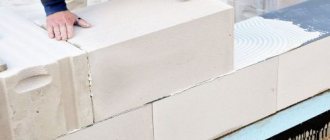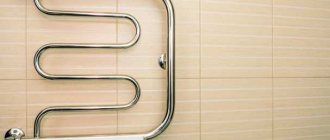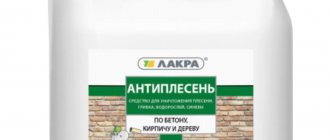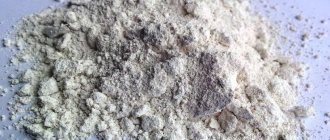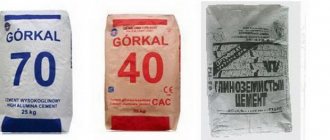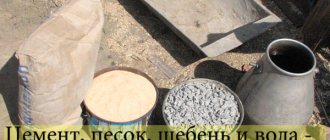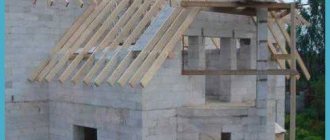The history of cement as a building material goes back many years, during which its structure, composition and technical characteristics have changed in order to improve its qualities and determine the most successful option. Today, cement is one of the main building materials, because it is very difficult to imagine carrying out any work without concrete.
Cement is an inorganic hydraulic binder of artificial origin, which, in the process of interaction with water and other liquids, creates a plastic mass that can harden and turn into a stone monolith with high strength characteristics. A special feature of cement is its ability to gain strength in humid conditions, which other mineral binders (air lime, gypsum, etc.) cannot do.
The main indicator of the properties of cement is its grade: the letter M and the numbers next to it indicate the level of compressive strength and other related characteristics (M200, M500). Cement is produced by finely grinding gypsum and clinker (a product of uniform firing to the state of sintering of homogeneous raw materials from clay and limestone). During the grinding process, various additives can be introduced into the composition to change the properties.
Types of cement according to main mineral:
- Romancement
– more belite, they don’t produce it now.
- Portland cement
– more alite, the most common.
- Magnesian (Sorel cement)
– based on magnesite, sealed only with an aqueous solution of salts.
- Aluminous
– the aluminate phase predominates.
- Biocement
- appeared thanks to the use of biotechnology in production.
- Acid resistant
– based on sodium hydrosilicate: a mixture of sodium silicofluoride and quartz sand is mixed with an aqueous solution of liquid glass.
Most often, Portland cement is used, which is produced by heating clay and limestone to +1450-1480 degrees. The mixture melts to form clinker granules, which are then ground with gypsum.
The main phases of a typical clinker for the production of Portland cement:
- Alit
– the most important component of clinker (50-70% of it), quickly reacts with water, affects strength, is especially important for 28-day strength.
- Belit
– 15-30% in the composition, reacts slowly, has little effect on strength for 28 days, but then increases the indicator.
- Aluminate
– 5-10%, reacts quickly with water, can cause too rapid setting (gypsum is often added to prevent this).
- Ferrite
– 5-15% in the composition, the rate of reaction with water may vary, but is usually high at the beginning, slows down later.
Who invented Portland cement?
Portland Cement/Inventors
Interesting materials:
How to remove a Bluetooth device on Windows 10? How to remove a device in Windows 10? How to remove VPNs in Windows 7? How to delete temporary files in Windows 7? How to delete all unnecessary files from a computer on Windows 10? How to remove all Windows 7 updates via command line? How to delete everything from a Windows 7 laptop? How to delete all saved passwords on a Windows 7 computer? How to remove all Windows 10 accounts? How to remove the built-in Windows 10 antivirus?
A little background about the material
The question of when cement was invented is difficult to answer. It is generally accepted that the main methods of producing binders were discovered in the 3rd-4th millennium BC. This happened during the burning of rocks and grinding of what came out. The very first artificially created binders were building gypsum and lime.
They were used in the construction of the concrete gallery of the labyrinth (Egypt, 3600 BC), the Great Wall of China, the Roman Pantheon, and ancient houses in Mexico.
Due to the fact that clay and gypsum can only harden in air, they are called air-based. The strength of the materials is relatively low. As the properties of materials were studied, their water resistance began to be increased by adding finely ground baked clay and volcanic rocks (these are “pozzolans” - the name comes from the location of the rocks in the city of Pozzuolli, ancient Rome).
Since 1584, the “Stone Order” began to operate in Moscow, aimed at the production of bricks, the procurement of stone for construction purposes, and the production of lime. For many years, gypsum and lime remained the main types of binders. In the 18th century, industry began to develop intensively in Russia; there were attempts to systematize knowledge about binders and create new types.
Cement was invented in 1822, when Russian builder Yegor Cheliev mixed clay with lime to create a material with astringent properties. A few years later, he published a book in which he fully described the process of preparing not only cement materials, but also concrete, and also examined the merits of their use in bricklaying, construction of buildings and embankments.
In 1824, Joseph Aspdin was able to come up with modern Portland cement, which, after being mixed with crushed stone, sand and water, could be used as concrete. The material withstood compression perfectly, but was afraid of stretching. Then they began to study other materials and knew that iron beams can withstand tension well, but are afraid of compression.
Almost simultaneously, several people decided to combine the properties of two materials for a better result. In the south of France in 1850, Jean-Louis Lambeau built several boats from concrete reinforced with iron mesh. In 1854, Briton William Wilkinson was the first to use concrete panels reinforced with iron beams in the construction of a 2-storey house in Newcastle.
At the same time, another builder, Francois Coignet, in France decided to experiment - he was the first to connect wall panels with steel reinforcement of the floors. True, this did not reach the masses. But reinforced concrete was introduced into practice by a person far from construction. The creation of reinforced concrete was one of the most important events in the history of construction.
In 1846, Joseph Monnier was appointed greenhouse gardener in the famous Tuileries Garden, near the Louvre. He needed durable garden tubs to transplant orange trees for the winter. Monier created several tubs from a mixture of cement, sand, ground brick, ash (concrete), but the structure was constantly covered in cracks. And then Monier decided to strengthen them with iron rods.
At that time it was generally accepted that iron destroys concrete due to temperature changes, but after 3 years all the tubs remained intact. Then Monier made water containers and landscape decoration elements in the same way, and in 1867 he introduced reinforced concrete to the world in Paris, patenting its use in artificial reservoirs. Then other patents were issued - for pools and pipes, building panels, bridge structures, sleepers and beams.
The material invented by Monier in 1875, under his own leadership, was used in the construction of a small bridge at the Chazelle Chateau. And then, in 1879, a civil engineer from Germany named Gustav Weiss bought all the patents from Monier and improved the design, moving the reinforcement to the side of the maximum tensile load (after all, Monier was not an engineer, he did not take such nuances into account).
Thus, Gustav Weiss completed the work on creating modern reinforced concrete. Cement has been very highly regarded since its inception. Today, almost no grandiose construction can be done without it; the material is used in all areas, in various products, structures, and buildings.
Cement is not a separate building material; this term denotes a group of substances with certain physical characteristics: powderiness, viscosity, the ability to create a plastic mass with water, and after drying, become a monolith. The process is always one-sided, nothing can be returned back.
Hardened cement will never return to its original state. The main components of cement are margel, clay, calcareous rocks, various additives (bauxite, slag, etc.). After high-tech and high-temperature processing, the raw material is fused (partially or completely), creating calcium aluminates/silicates, which makes it durable. There are many types of cement.
Additives in cement are designated by the letter D and indicate the percentage (D20 - 20% of modifying additives). If the cement is clean, it costs D0. Thanks to additives, it is possible to increase such indicators as resistance to water and corrosion, frost and sun, elasticity and plasticity, as well as others.
What is cement made of, composition and proportions of raw materials
The requirements for the physical and chemical properties of cement affect the composition. There are clear proportions of what cement consists of - it is clay and limestone in a ratio of 3:1.
The main components of cement:
- Clinker (obtained by burning limestone and clay. Under the influence of high temperature, melting occurs and a mass is obtained with a high content of silica and calcium dioxide. The physical properties of the material depend on these substances).
- Gypsum (how quickly the solution hardens depends on its quantity).
- Additives to impart certain properties.
The starting materials for cement production are various rocks. These can be carbonate-type fossils (marl, chalk, shell rock, dolomite rocks) or sedimentary rocks (loam, loess, shale).
Proportions of raw materials for cement production:
- 60% – lime.
- 20% – silicon dioxide.
- 4% – aluminum.
- 2% – gypsum.
Corrective additives include: mineralizers, iron, belite sludge, apatites, alumina, etc.
The most common cement composition, Portland cement, has the following proportions: 25% silica, 60% lime, 10% gypsum and iron oxide, 5% alumina.
It is sometimes said that concrete is the same as cement, but this is a false statement.
What can you spend your maternity capital on in 2022?
The purposes for which maternity capital funds can be directed are specified in Art. 7 Federal Law “On additional measures of state support for families with children.” The payment can be spent on children’s education, receiving monthly payments (if the family’s income is below the subsistence level), social adaptation of disabled children, or used to form the funded part of the mother’s pension.
One of the most popular ways to use a certificate is to improve living conditions: building and buying a house, apartment and paying off a mortgage. According to the Ministry of Labor, in 2022, about 61% of program participants spent money on these purposes. For comparison, for education - 17%, for monthly payments - 22%, for mother's funded pension - less than 1%.
Let's take a closer look at the most popular areas of using matkapiatal.
Buying a home and mortgage
Maternity capital funds can be used to purchase an apartment, house using your own funds or for a mortgage. Typically, the certificate is used to pay off the principal of a home loan, refinance, or make a down payment. In the latter case, it is better to add your own savings - this way you have a higher chance of getting approval.
“Contributing only maternity capital (if provided for by the bank’s program) cannot be a reason for refusal, but it should be understood that the larger the amount of the down payment, the more willingly the bank gives a loan. This is associated with risks, because the more a person invests his money, the less likely it is that he will refuse to pay and want to lose his apartment,” explained Natalia Kuznetsova, general director of the Bon Ton real estate agency.
Matkapital can also be used when participating in preferential programs - Far Eastern, rural, family, military mortgages. Starting last year, it became possible to apply for the most popular area of the program - the purchase or construction of housing with a mortgage - directly from the bank where the loan was opened. Banks collect the necessary documents.
Construction and reconstruction of a house
The certificate can be spent on the reconstruction and construction of a country house, including with the help of a loan. From 2022, using these funds, a family can build housing not only on a plot for individual housing construction, but also a house on a garden plot. In addition, maternity capital funds can be used to reconstruct a residential building on a garden plot or compensate for the costs of its construction (reconstruction).
You can spend maternity capital on the reconstruction and construction of country housing only if the premises have the status of a residential building, are intended for permanent residence, and the owner of the certificate (spouse) has the right of ownership (use, possession, lease) to the land and permission to build housing ( notice of planned construction). You can build or reconstruct a residential building on a garden plot using capital on your own or by engaging a construction company and concluding a contract.
In March 2022, changes came into force according to which, to confirm that the house was built, you need to provide an extract from the Unified State Register. Previously, information was required from the inspection report of the main work on the construction of a residential building. The house itself must have been built after January 1, 2007. If it was built before this date, the family can only spend capital on its reconstruction.
Purchase of land and renovation
Maternity capital funds can be used to purchase a residential building, but not land, so they can only be spent on a plot for individual housing construction or land in an SNT (horticultural non-profit partnership). “You cannot buy a plot of land with maternity capital. You also cannot use maternal capital when purchasing apartments,” noted Natalia Kuznetsova.
It is also impossible to use maternity capital funds to renovate an apartment or house. Although this option is being discussed. In June, Russian President Vladimir Putin agreed to consider the possibility of using maternity capital for home renovations. "You might think. Only the criteria here are very vague - you need to understand what kind of repairs, why they weren’t done and whether this money will not be wasted,” he clarified.
Types of cement, what they are, application
According to GOST, the packaging of the mixture must contain information about it: name, manufacturer, class and brand. The grade indicates the tensile strength of the hardened sample in kilograms per square centimeter. Strength depends on what the cement is made from.
Mixtures marked M300 are used during the installation of structures without heavy loads.
M400 cement is suitable for the production of reinforced concrete products and low-rise construction.
The M500 grade is used for the construction of multi-storey buildings and the production of high-strength reinforced concrete products.
The most durable type of cement, M600, is used for the construction of bridges and the construction of military facilities.
Labeling by type of additives
Cement grades are specified in GOST 31108-2016. This is a sequence of letters and numbers, which depends on the additives used during production and the intended purpose of the mixture.
The first is the designation of the type of mixture:
- CEM I is ordinary Portland cement without additives.
- CEM II - Portland cement with mineral additives (if the additives are from 5 to 20%, then the letter A is added to the marking, if from 21 to 35% - B).
- CEM III - slag Portland cement, contains ground slag (has three subtypes depending on its amount in the mixture: A - from 6 to 20%, B - from 21 to 35%, C - from 36 to 60%).
- CEM IV is pozzolanic cement with additives of volcanic origin.
- CEM V is a composite cement that may include several additives.
After the Latin letters A, B and C, the type of additive is indicated in Cyrillic:
- And - limestone.
- M, MK – microsilica.
- W – fly ash.
- Sh – slag.
- P – pozzolans.
- G – gliezh.
- K – composite, containing several additives.
Next in the marking is the strength class of the frozen material. It is considered normal to gain strength within 28 days, although testing is also carried out on the second and seventh days. After this, on the 28th day, the sample is tested on a special machine. The numbers indicate what pressure in MPa the material can withstand.
The correspondence of class and brand is presented in the table:
| Class | Brand |
| 22,5 | M300 |
| 32,5 | M400 |
| 42,5 | M500 |
| 52,5 | M600 |
The numbers may be followed by the letters B, N or M. They indicate at what speed the solution will harden: fast-hardening, normal-hardening or slow-hardening. This indicator depends on what the cement mixture was made from.
Sometimes the packaging is also marked “CC”. It does not apply to modern GOST and indicates that the composition is sulfate-resistant.
Manufacturers often indicate outdated GOST 10178-85 on the packaging. The material markings are different. To avoid confusion, you can use the marking correspondence table.

